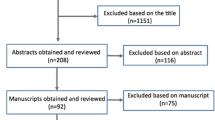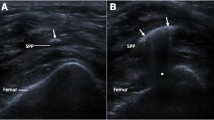Abstract
Objective
The purpose of this study was to evaluate the accuracy of in vivo acromioclavicular (AC) joint injections without fluoroscopic guidance and assess whether patient demographics affected the accuracy of injections.
Materials and methods
A consecutive cohort of patients who presented with painful acromioclavicular joints was prospectively evaluated. All patients had clinical and radiographic evidence of AC arthritis, had failed conservative measures, and thus had received intraarticular corticosteroid injections. All injections were performed by experienced fellowship-trained musculoskeletal radiologists and by blinded digital palpation technique. Accuracy of injections was assessed with biplanar fluoroscopic views.
Results
Forty-one AC injections in 22 males and 16 females with a mean age of 51 years (range 18 to 78) were identified. Twenty-three injections were in the right shoulder and 18 in the left. Only 15 injections were confirmed to be in the intraarticular AC joint, yielding an accuracy of 36.5 %. There were no significant differences in the mean age (54 vs. 52 years; p = 0.58), male-to-female ratio (p = 0.73), and side of the injection between the accurate and inaccurate injections, respectively.
Conclusion
Based on the findings of the present study, the authors encourage the use of image guidance for corticosteroid treatment of the AC joint.
Level of Evidence: Level IV Therapeutic Case Series




Similar content being viewed by others
References
Partington PF, Broome GH. Diagnostic injection around the shoulder: hit and miss? A cadaveric study of injection accuracy. J Shoulder Elbow Surg. 1998;7(2):147–50.
Dalinka MK, Stewart V, Bomalaski JS, Halpern M, Kricun ME. Periarticular calcifications in association with intra-articular corticosteroid injections. Radiology. 1984;153(3):615–8.
Ford LT, DeBender J. Tendon rupture after local steroid injection. South Med J. 1979;72(7):827–30.
O’Brien SJ, Pagnani MJ, Fealy S, McGlynn SR, Wilson JB. The active compression test: a new and effective test for diagnosing labral tears and acromioclavicular joint abnormality. Am J Sports Med. 1998;26(5):610–3.
Hiemstra LA, Macdonald PB, Froese W. Subacromial infection following corticosteroid injection. J Shoulder Elbow Surg. 2003;12(1):91–3.
Wasserman BR, Pettrone S, Jazrawi LM, Zuckerman JD, Rokito AS. Accuracy of acromioclavicular joint injections. Am J Sports Med. 2013;41(1):149–52.
Sabeti-Aschraf M, Lemmerhofer B, Lang S, et al. Ultrasound guidance improves the accuracy of the acromioclavicular joint infiltration: a prospective randomized study. Knee Surg Sports Traumatol Arthrosc. 2011;19(2):292–5.
Pichler W, Weinberg AM, Grechenig S, Tesch NP, Heidari N, Grechenig W. Intra-articular injection of the acromioclavicular joint. J Bone Joint Surg (Br). 2009;91(12):1638–40.
Borbas P, Kraus T, Clement H, Grechenig S, Weinberg AM, Heidari N. The influence of ultrasound guidance in the rate of success of acromioclavicular joint injection: an experimental study on human cadavers. J Shoulder Elbow Surg. 2012;21(12):1694–7.
Bisbinas I, Belthur M, Said HG, Green M, Learmonth DJ. Accuracy of needle placement in ACJ injections. Knee Surg Sports Traumatol Arthrosc. 2006;14(8):762–5.
Keats TE, Pope Jr TL. The acromioclavicular joint: normal variation and the diagnosis of dislocation. Skeletal Radiol. 1988;17(3):159–62.
Renfree KJ, Wright TW. Anatomy and biomechanics of the acromioclavicular and sternoclavicular joints. Clin Sports Med. 2003;22(2):219–37.
Informed consent was obtained from all patients included in the study.
All study procedures were followed in accordance with the ethical standards of the responsible committee on human experimentation (institutional and national) and with the Helsinki Declaration of 1975, as revised in 2000 and 2008.
Conflict of interest
AJS declares that he has no conflict of interest.
KI declares that he has no conflict of interest.
VKM declares that he has no conflict of interest.
EM declares that he has no conflict of interest.
RB declares that he has no conflict of interest.
UD declares that he has no conflict of interest.
AF declares that he has no conflict of interest.
Author information
Authors and Affiliations
Corresponding author
Rights and permissions
About this article
Cite this article
Scillia, A., Issa, K., McInerney, V.K. et al. Accuracy of in vivo palpation-guided acromioclavicular joint injection assessed with contrast material and fluoroscopic evaluations. Skeletal Radiol 44, 1135–1139 (2015). https://doi.org/10.1007/s00256-015-2137-1
Received:
Revised:
Accepted:
Published:
Issue Date:
DOI: https://doi.org/10.1007/s00256-015-2137-1




